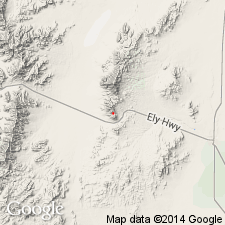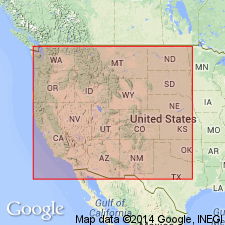
- Usage in publication:
-
- Cactus Quartz Monzonite
- Modifications:
-
- Named
- AAPG geologic province:
-
- Great Basin province
Summary:
Unit is named the Cactus Quartz Monzonite. Consists of dark-gray, medium-grained, holocrystalline, generally altered quartz monzonite. Includes stock and dike. Intrudes Paleozoic sedimentary rocks. Age is Tertiary.
Source: GNU records (USGS DDS-6; Menlo GNULEX).

- Usage in publication:
-
- granodiorite of Cactus stock
- Modifications:
-
- Geochronologic dating
- AAPG geologic province:
-
- South Western Overthrust
Summary:
Pg. 28, geologic time scale (inside front cover). granodiorite of Cactus stock [in Cactus Quartz Monzonite]. Granodiorite sample from Portal Cactus Mine audit, San Francisco district, in NE/4 sec. 9, T. 27 S., R. 13 W., Lat. 38 deg. 29 min. 03 sec. N., Long. 113 deg. 18 min. 46 sec. W., Frisco quadrangle, Beaver County, Utah, yielded a K-Ar age of 28.7 +/-0.9 Ma (biotite). Age of 28 Ma published by Marvin (1968); recalculated using decay constants of Steiger and Jager, 1977 (Earth Planet. Sci. Letters, v. 36, p. 359-362). [Oligocene, based on time scale of Berggren, 1972, Lethaia, v. 5, no. 2, p. 195-215.]
Source: Publication.
For more information, please contact Nancy Stamm, Geologic Names Committee Secretary.
Asterisk (*) indicates published by U.S. Geological Survey authors.
"No current usage" (†) implies that a name has been abandoned or has fallen into disuse. Former usage and, if known, replacement name given in parentheses ( ).
Slash (/) indicates name conflicts with nomenclatural guidelines (CSN, 1933; ACSN, 1961, 1970; NACSN, 1983, 2005, 2021). May be explained within brackets ([ ]).

